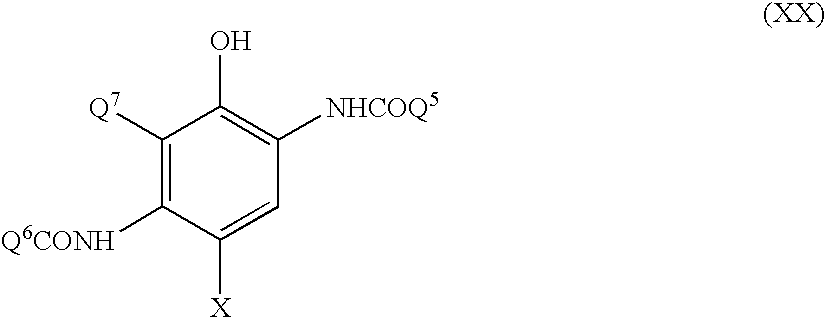Silver halide photographic material
a silver halide and photographic technology, applied in the field of silver halide photographic materials, can solve the problems of affecting the photographic properties, difficult to predict the effect of the first hand, and still impossible to predict the photographic properties in the present circumstances, and achieves the effects of reducing residual colors, minor fluctuations in photographic characteristics, and high sensitivity
- Summary
- Abstract
- Description
- Claims
- Application Information
AI Technical Summary
Benefits of technology
Problems solved by technology
Method used
Image
Examples
example 1
(Preparation of Sample)
Both faces of a support comprising paper coated with a polyethylene resin on both faces thereof was subjected to corona discharge treatment, and then, a gelatin undercoat layer containing sodium dodecylbenzenesulfonate was provided thereon. Further, first to seventh photographic constituent layers were in turn provided to form sample 101 of a silver halide color photographic material having the following layer constitution. Coating solutions for the respective photographic constituent layers were prepared as described below.
Preparation of Coating Solution for Fifth Layer:
A cyan coupler (ExC) (300 g), 250 g of a color image stabilizer (Cpd-1), 10 g of a color image stabilizer (Cpd-9), 10 g of a color image stabilizer (Cpd-10), 20 g of a color image stabilizer (Cpd-12), 14 g of an ultraviolet absorber (UV-1), 50 g of an ultraviolet absorber (UV-2), 40 g of an ultraviolet absorber (UV-3) and 60 g of an ultraviolet absorber (UV-4) were dissolved in 230 g of a solv...
example 2
(Preparation of Sample 501)
(1) Preparation of Triacetyl Cellulose Film
Triacetyl cellulose was dissolved in a 92 / 8 (weight ratio) mixed solvent of dichloromethane / methanol (in an amount of 13% by weight), and triphenyl phosphate and biphenyldiphenyl phosphate (weight ratio: 2:1) were added thereto as plasticizers in a total amount of 14% based on triacetyl cellulose. The resulting product was formed to a film by a band method according to a solvent casting process. The thickness of the support after drying was 97 μm.
(2) Contents of Undercoat Layer
The following undercoat solution was applied onto both faces of the above-mentioned triacetyl cellulose film. The numerals indicate the weight contained per liter of undercoat solution.
The both faces were subjected to corona discharge treatment before application of the undercoat solution.
Gelatin10.0gSalicylic Acid0.5gGlycerol4.0gAcetone700mlMethanol200mlDichloromethane80mlFormaldehyde0.1mgWater to make1.0liter
The f...
example 3
(Preparation of Samples)
Samples 901 to 909 and 1001 to 1009 were prepared in the same manner as with Example 1 with the exception that cyan coupler ExC of the fifth layers of samples 101 to 109 prepared in Example 1 was replaced with couplers shown Table 6, respectively, so as to give the same maximum color formation density. Each sample was processed to a roll form having a width of 127 mm.
(Evaluation of Residual Color of Dye)
For samples 100 to 109, 901 to 909 and 1001 to 1009, continuous processing (running test) was conducted by the processing steps described in Example 1 until a replenisher was replenished twice the amount of a color developing tank, at a ratio of 25% / 75% of a sample fogged by white light / an unexposed sample, using respective color developing solutions (running processing solutions 100 to 109, 901 to 909 and 1001 to 1009).
Using a sensitometer, samples 100 to 109, 901 to 909 and 1001 to 1009 were exposed through a color separation filter and a gradation wedge for...
PUM
| Property | Measurement | Unit |
|---|---|---|
| charge | aaaaa | aaaaa |
| acid | aaaaa | aaaaa |
| storage stability | aaaaa | aaaaa |
Abstract
Description
Claims
Application Information
 Login to View More
Login to View More - R&D
- Intellectual Property
- Life Sciences
- Materials
- Tech Scout
- Unparalleled Data Quality
- Higher Quality Content
- 60% Fewer Hallucinations
Browse by: Latest US Patents, China's latest patents, Technical Efficacy Thesaurus, Application Domain, Technology Topic, Popular Technical Reports.
© 2025 PatSnap. All rights reserved.Legal|Privacy policy|Modern Slavery Act Transparency Statement|Sitemap|About US| Contact US: help@patsnap.com



